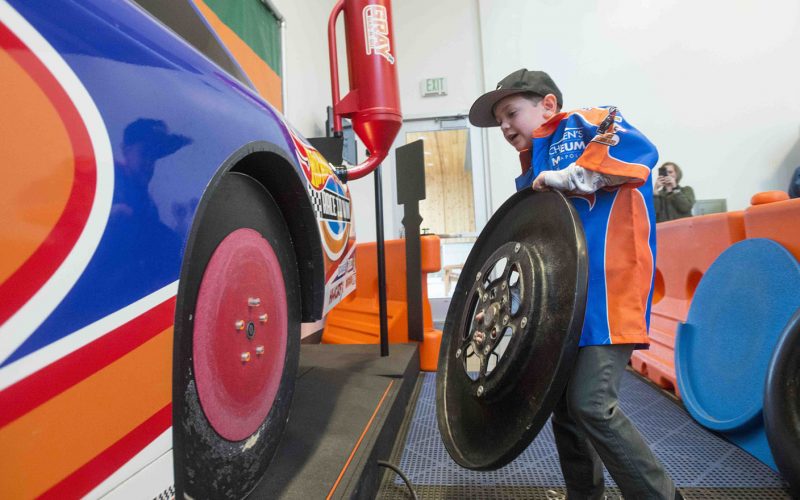Hot Wheels rev up fun at Amazeum
For the Children’s Museum of Indianapolis, “the idea for the exhibit was pretty simple at the start.”
“We had worked with Mattel on several prior projects, including a [temporary] exhibit at our museum called ‘Hot Wheels For Real!’ which was about the designs of the toy cars and how those designs sometimes can turn into real-life, full-sized vehicles,” says Cathy Hamaker, exhibit developer at CMI. “So we knew kids love Hot Wheels, and Mattel was interested in doing a project with us that could be a traveler. To distinguish it from the prior exhibit, and to make the content more broadly interesting to both children’s museums and science centers, we decided to develop it around the science and physics of motorsports, using Hot Wheels cars to illustrate the content.”
That’s how “Hot Wheels: Race to Win,” now open at the Amazeum in Bentonville, was born. How it came to fruition is a much more complicated story.

The Free Weekly/BEN GOFF
McKenna Dorey (left), 7, of Bentonville and Cambria Fish, 9, of Rogers race Hot Wheels cars Friday, Jan. 26, 2018, during a media preview of the new Hot Wheels: Race to Win exhibit at the Scott Family Amazeum in Bentonville. The interactive exhibit created by the Children’s Museum of Indianapolis, takes a behind-the-scenes look into the world of auto racing and coincides with the 50th anniversary of Hot Wheels. The exhibit opened to the general public Saturday, Jan. 27 and runs through April 29.
“Once we’d decided on this direction, we did a bunch of research on how schools teach these topics (basic physics, simple machines, etc.) and built the content around that,” Hamaker says. “We knew we wanted to have lots of Hot Wheels toys (vintage and current) on display, as well as real car parts and pieces, and of course hands-on stuff for kids to do and play with. The exhibit was designed and built in-house at our museum, so we had a lot of control over the look and feel of the gallery, with input from Mattel’s designers as well.
“As to where we got the stuff — most of the vintage toys on display were purchased on Ebay or similar sites,” Hamaker adds. “The actual parts of cars, driver suits, helmets, etc., were mostly donated by various racing teams here in Indianapolis — as you might imagine we had a lot of resources available to us, and our museum has connections with several of the big racing teams and car manufacturers for Indy car and drag/hot rod. We basically got to go through their closets and storage areas and pull out tons of stuff that was either past its prime or no longer being used.
“NASCAR stuff was a little tougher to get because the teams aren’t based here; I think we bought a few things at auction for that as well.”
For the Amazeum, “Hot Wheels: Race to Win” was “an exhibit that all age groups can experience,” says spokesman Paul Stolt. “Hot Wheels cars have been a part of millions of kids lives for 50 years. The Scott Family Amazeum is a family museum, and this exhibit has something for the whole family. It’s a hands-on exhibit that grandparents, parents and children can connect with and share experiences.”
Stolt says for him “Hot Wheels [was] the official vehicle of make-believe cities. All the neighborhood kids would bring their cars out to the huge elm tree in my neighbor’s yard and start to build streets, buildings and highways in the roots and dirt. We used the track to make elaborate raceways and then test which car could stay on the track. Hot Wheels introduced me to cars. More importantly, they were a vehicle for bringing the neighborhood together to play with a common purpose and create an opportunity to work together.”
Visitors to the Amazeum can do all those things and more, Stolt says.
“The exhibit consists of four zones,” he explains. “In the Blue Zone, it’s all about designing the car to maximize performance by learning about what makes one car faster than another. The Yellow Zone is about power. In this zone, it’s about learning what makes a car go fast. In the Green Zone, it’s all about speed and what drivers and their teams do to be first across the finish line. And in the Red Zone, families learn about safety and how keeping a driver safe is the top priority for racing teams.
“Interacting with the cars in the exhibit provides opportunities for wonder, experimentation and discovery,” Stolt concludes. “For kids, they might observe that one car is faster and start to look for clues as to why, perhaps finding an identical car and testing their hypothesis. They may not know explicitly that they are following a process, but years later in science class, they might make a connection to the time they tested the Hot Wheels cars at the Amazeum and the theory becomes reality. Inherent in play are those ‘a-ha’ and ‘wow’ moments that lead to learning and discovery.”
__
FAQ
‘Hot Wheels:
Race to Win’
WHEN — Through April 29; museum hours are 1-5 p.m. Sunday; 10 a.m.-5 p.m. Monday; closed Tuesday; 10 a.m.-5 p.m. Wednesday-Saturday
WHERE — Scott Family Amazeum in Bentonville
COST — $9.50; children younger than 2 are admitted free
INFO — 696-9280 or amazeum.org
BONUS — Priceless Nights, when families may “pay as they wish,” take place on selected Wednesdays from 4 to 7 p.m. Dates during the “Hot Wheels” exhibit are Feb. 21, 28; March 7, 14, 28; and April 4, 11, 18 & 25.
BECCA MARTIN-BROWN
bmartin@nwadg.com



